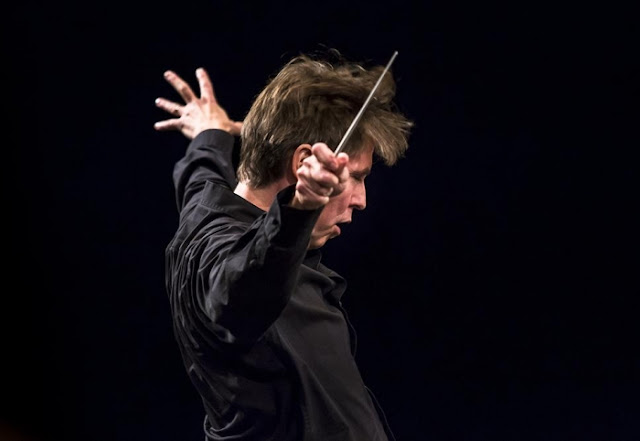Esa-Pekka Salonen and the MET Orchestra end the Carnegie Hall season.
by Paul J. Pelkonen
 |
| In flight: Esa-Pekka Salonen. Photo by Nicolas Brodard © 2017 the Philharmonia Orchestra. |
The Carnegie Hall subscription season ended Tuesday night with an epic concert featuring conductor-composer Esa-Pekka Salonen, the MET Orchestra and a heaping program of four works by Gustav Mahler and Jean Sibelius. These two composers remain touchstones of Mr. Salonen’s long and successful podium career. With bold repertory choices (including a Mahler piece that, unaccountably, may have had its Carnegie Hall premiere at his very concert!) and a starry pair of guests, this proved a revelatory and engrossing evening.
The premiere, (if it was one, program notes seemed uncertain on the subject) was “Blumine”, a free-standing orchestral movement by Mahler that originally occupied the position of second movement in that composer’s Symphony No. 1. When Mahler pruned this flowery movement from his Symphony, “Blumine" became a bit of orchestral apocrypha. It shows up on recordings by completist Mahler conductors (notably David Zinman) but almost never heard in the standard concert repertory. This is a mistake.
Mr. Salonen found the very best qualities in this ten-minute Andante, a lilting dance for flowery strings that recalled the second act of Wagner's Parsifal. This supported a bold and eloquent trumpet solo that carried the main theme before turning it over to the winds for a set of gentle variations, The work sounded familiar and yet not. This piece was written by Mahler well before the premiere of the First and was inserted into that symphony by the composer. Said insertion that was undone in the composers 1896 revision, Mr. Salonen and the Met players made a good argument for it to be heard more often, either with or without the other movements of the First.
The orchestra was then joined by soloist Christian Tetzlaff for a wild ride through Sibelius' Violin Concerto. Mr. Salonen and Mr. Tetzlaff made mischief and merriment in the first movement, insisting stretches of rubato and accelerandi that stretched and loosened the musical fabric but did not tear it. The overall effect was one of freshness and originality another kind of cerebral performance that Mr, Salonen is known for and the passionate and precise playing that is Mr. Tetzlaffs stock in trade.
Following the rambunctious finale, Mr. Tetzlaff returned to offer a substantial encore, one that was even more exciting than the aforementioned concerto. This was the final movement of Béla Bartók’s Sonata for Solo Violin. This is a hefty movement that includes quarter-tones and microtonal bowing around the bridge of the violin. These slithering sounds were couched in music that also reflected the composers Hungarian roots, the song a Romany toddler had suddenly indulged in a psychedelic substance while in the middle of a solo. Marvelous stuff, and one hopes that Mr. Tetzlaff will include the complete piece in his current touring rep.
The second guest of the evening was Anne Sofie Von Otter, singing the orchestral versions of Mahler’s Kindertotenlieder. These settings of five Songs On the Death of Children made the Wagnerian nature of Mahler's writing for voice and orchestra readily apparent. Mr. Salonen underlined references to the tritone and the Tristan chord, which served as a connecting link between these sweet and painfully sad songs. The finale “Im diesen Wetter” was the most moving of all, stormy and aggressive in its opening pages, and unbearably slow and sad as it drew to a hushed close.
The final item in this extraordinary program was Sibelius' Seventh Symphony, a twenty-minute single movement work that serves a summing-up of that composer’s considerable musical gifts. Mr. Salonen was expert in his handling of the rapid and very subtle tempo shifts between the different sections of this knotty piece. The orchestra responded with full-throated strings and a purring roar from the trombones, bringing the final pages of this great work together in a transcendent glow that lingered with the listener long after the music stopped.




